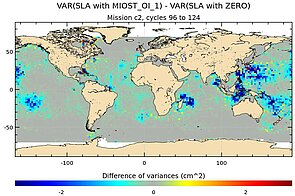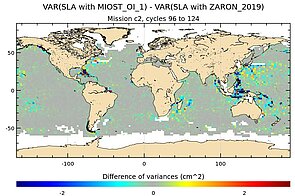Multivariate Inversion of Ocean Surface Topography, Internal Tide Model (MIOST-IT)
Types of dataset: auxiliary products
DOI: 10.24400/527896/a01-2022.003 - more metadata
Contents: MIOST-IT database includes 4 tidal components for the ocean internal tide surface elevations. Each tidal component is described by 2 grids (amplitude and phase) provided on a cartesian grid 1/10°x1/10°.
- The internal tide elevations for the four tidal frequencies M2, S2, K1, O1, are available for download.
- The tidal prediction code is also available to download including a README file in a "prediction" folder.
Use: open ocean oceanography, operational oceanography, ocean circulation, tide studies
Description: MIOST-IT solution is based on an original gridding process using ocean signals modes variability and all altimeter measurements available on the nearly entire altimeter era
Geographic coverage: global between latitudes +/-68.5°,notice that diurnal tides are filled with zeros for |Lat| > 30° for O1 and for |LAt| > 32° for K1.
Format: NetCDF-4
Distribution media:
- Data files are on the authenticated FTP (see this note if you are facing problem using the ftp protocol with your browser)
- The source code is also distributed
Condition of access: Internal tide elevations are delivered for any purposes, as stated in licence agreement
File weight: 103 MB by file (4 files) plus the prediction code (6 KB)
Tools: source of the prediction algorithm in Python
Documentation: More details about the MIOST-IT model construction, its performances and the prediction code, are available in the User Handbook
How to cite this product?
Reference: Clement Ubelmann, Loren Carrere, Chloé Durand, Gérald Dibarboure, Yannice Faugère and Florent Lyard: Simultaneous estimation of Ocean mesoscale and coherent internal tide Sea Surface Height signatures from the global Altimetry record, https://doi.org/10.5194/os-2021-80 pdf
Figures: reduction of the along-track Cryosat-2 SLA variance when using the new MIOST-IT M2 model instead of a zero IT correction (left), or instead of the Zaron-2019 M2 solution (right). Blue spots indicate an improvement when using the MIOST-IT solution. Analysis was conducted on C2 cycles 96-124, which are independent from both the MIOST-IT and the Zaron_2019 models.
The following links propose animations of the M2 baroclinic tides on the global ocean:
Copyright: 2021 – CLS/OCEAN-NEXT/CNES/LEGOS






